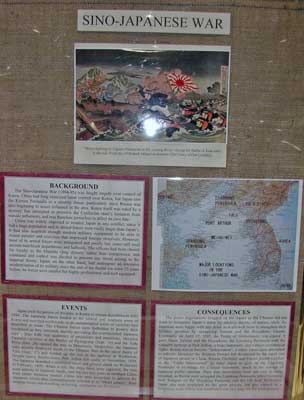Nambu World: Easter 2009 Murata Rifle Display


I did a totally new display based around my Murata rifles for this year's Alberta Arms and Cartridge Collectors Association Easter Gun Show. It was held April 10-11, 2009 at the Calgary Stampede Grounds, and is Canada's largest gun show, with 692 tables (yes, I know there are shows in the US with thousands of tables, but this is Canada). Here is an overview shot of the display, which was 18 feet long, and a shot of the main title board. The art on the board is two period prints from the 1890s. The top one is one piece and the lower one is a triptych (three-part picture). Both are done in the highly stylized fashion common in Japanese military art at the time. Photography was not yet common on the Asian battlefields and even Western art styles had not yet totally displaced traditional Japanese ones. Artists created fanciful images of battles they had never seen.


The first case had my three Murata rifles with a panel behind it to explain their history. The top rifle is a Type 13 (1880), the middle one a Type 18 (1885) and the bottom one a Type 22 (1889). The Types 13 and 18 are 11mm single shots while the Type 22 is an 8mm, 8-shot tube magazine repeater. You can find out more about these rifles on my web page on them at: Nambu World: Murata Rifles There are only four Murata rifles registered in Canada apart from the three I own, so they got a fair bit of attention.


Next came the bayonets. Again, the Type 13 is on the top, the Type 18 in the middle, and the two variations of Type 22 on the bottom.
You can find out more about the bayonets on my web pages at Nambu World: Murata Rifle Bayonets


The third case had the cartridges. I only have one deactivated cartridge for each calibre, so I filled out the rest of the case with similar period cartridges for comparison, and a few period photos. The cartridges are covered in detail on the rifle pages to which links are given above.
The last three cases show the conflicts in which these
rifles were used: the Sino-Japanese War (1894-95), the
Relief of Peking in the Boxer Rebellion (1900) and the Russo-Japanese War
(1904-05). 

The Sino-Japanese War case had the service medal for that war with an award certificate, service record book, and documents authorizing discharge money to soldiers who participated in the war. There are also a few period coins.

Since all these events occurred during the Meiji Era (1868-1912), when Japan was emerging from feudalism and modernizing and Westernizing at a furious pace, I included a panel to explain this historical background.


The Russo-Japanese War case shows a period book with a soldier equipped with a Type 22 rifle guarding artillery shells during the siege of Port Arthur. The Type 22 was obsolete by that time, but still had to be used in rear echelons since there were not enough of the new Type 30 Arisaka rifles to go around. The book was a generous gift from Mr. Joe de Vicq of San Antonio, Texas, who has contributed many rare items to my collection.There is also a service medal and award document, Red Cross and victory commemoration medals, a commemorative sake cup, and a medal for the annexation of Korea, which happened in 1910 as a direct result of the war. The right corner has orders assigning a soldier to his unit and then granting him an Order of the Sacred Treasure and discharge money for his service.


The final panel and case relate to the Boxer Rebellion. The case has the Boxer Rebellion service medal, a sake cup commemorating the expedition, a map from a 1900 Japanese newspaper showing the theatre of operations, and the service record book of a soldier who served in the Boxer Rebellion. The case also has his Type22 rifle manual and the loose leaf diagram from it, as well as his ship's boarding pass. The revolver is a Type 26 (1893). It is a low-numbered specimen (#5070) that would have been in service by the time of the expedition.

Here I am receiving an award for the display. This year the Military Collector's Club of Canada (MCC) held its annual convention at the show, so there were far more displays than usual, about 28, I think. I won first prize in the "Judges' Award" category. There is a Best of Show and then First and Second in each of three categories, and then four Judges' Awards, so that means I was about 8th overall. I also got C$150 in prize money, which was enough to cover the cost of the tables and my meals during the show. Best in Show was taken by a comprehensive display of ceremonial daggers of the Third Reich.


The AACCA Award is on the left. The MCC gave a plaque to all members who did a display, which was about ten people.
Last updated: April 16, 2009. All contents are copyright Teri unless otherwise
specified and may not be used elsewhere in any form without prior permission.
Click here to go back to the Nambu
World main page: Nambu World: Terifs Japanese Handgun Website